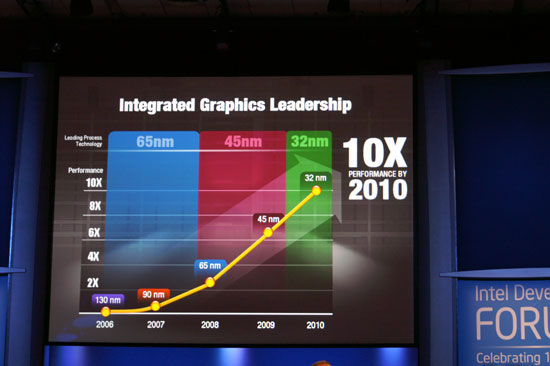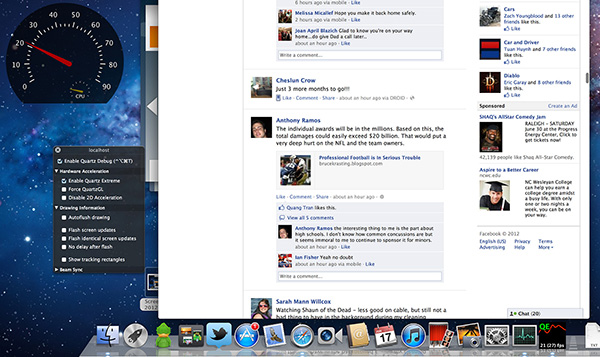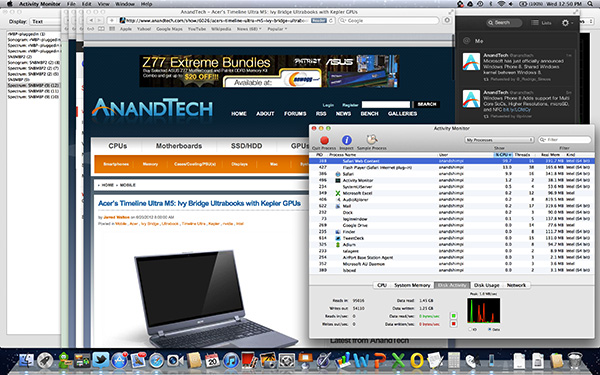The next-gen MacBook Pro with Retina Display Review
by Anand Lal Shimpi on June 23, 2012 4:14 AM EST- Posted in
- Mac
- Apple
- MacBook Pro
- Laptops
- Notebooks
Driving the Retina Display: A Performance Discussion
As I mentioned earlier, there are quality implications of choosing the higher-than-best resolution options in OS X. At 1680 x 1050 and 1920 x 1200 the screen is drawn with 4x the number of pixels, elements are scaled appropriately, and the result is downscaled to 2880 x 1800. The quality impact is negligible however, especially if you actually need the added real estate. As you’d expect, there is also a performance penalty.
At the default setting, either Intel’s HD 4000 or NVIDIA’s GeForce GT 650M already have to render and display far more pixels than either GPU was ever intended to. At the 1680 and 1920 settings however the GPUs are doing more work than even their high-end desktop counterparts are used to. In writing this article it finally dawned on me exactly what has been happening at Intel over the past few years.
Steve Jobs set a path to bringing high resolution displays to all of Apple’s products, likely beginning several years ago. There was a period of time when Apple kept hiring ex-ATI/AMD Graphics CTOs, first Bob Drebin and then Raja Koduri (although less public, Apple also hired chief CPU architects from AMD and ARM among other companies - but that’s another story for another time). You typically hire smart GPU guys if you’re building a GPU, the alternative is to hire them if you need to be able to work with existing GPU vendors to deliver the performance necessary to fulfill your dreams of GPU dominance.
In 2007 Intel promised to deliver a 10x improvement in integrated graphics performance by 2010:

In 2009 Apple hired Drebin and Koduri.
In 2010 Intel announced that the curve had shifted. Instead of 10x by 2010 the number was now 25x. Intel’s ramp was accelerated, and it stopped providing updates on just how aggressive it would be in the future. Paul Otellini’s keynote from IDF 2010 gave us all a hint of what’s to come (emphasis mine):
But there has been a fundamental shift since 2007. Great graphics performance is required, but it isn't sufficient anymore. If you look at what users are demanding, they are demanding an increasingly good experience, robust experience, across the spectrum of visual computing. Users care about everything they see on the screen, not just 3D graphics. And so delivering a great visual experience requires media performance of all types: in games, in video playback, in video transcoding, in media editing, in 3D graphics, and in display. And Intel is committed to delivering leadership platforms in visual computing, not just in PCs, but across the continuum.
Otellini’s keynote would set the tone for the next few years of Intel’s evolution as a company. Even after this keynote Intel made a lot of adjustments to its roadmap, heavily influenced by Apple. Mobile SoCs got more aggressive on the graphics front as did their desktop/notebook counterparts.
At each IDF I kept hearing about how Apple was the biggest motivator behind Intel’s move into the GPU space, but I never really understood the connection until now. The driving factor wasn’t just the demands of current applications, but rather a dramatic increase in display resolution across the lineup. It’s why Apple has been at the forefront of GPU adoption in its iDevices, and it’s why Apple has been pushing Intel so very hard on the integrated graphics revolution. If there’s any one OEM we can thank for having a significant impact on Intel’s roadmap, it’s Apple. And it’s just getting started.
Sandy Bridge and Ivy Bridge were both good steps for Intel, but Haswell and Broadwell are the designs that Apple truly wanted. As fond as Apple has been of using discrete GPUs in notebooks, it would rather get rid of them if at all possible. For many SKUs Apple has already done so. Haswell and Broadwell will allow Apple to bring integration to even some of the Pro-level notebooks.
To be quite honest, the hardware in the rMBP isn’t enough to deliver a consistently smooth experience across all applications. At 2880 x 1800 most interactions are smooth but things like zooming windows or scrolling on certain web pages is clearly sub-30fps. At the higher scaled resolutions, since the GPU has to render as much as 9.2MP, even UI performance can be sluggish. There’s simply nothing that can be done at this point - Apple is pushing the limits of the hardware we have available today, far beyond what any other OEM has done. Future iterations of the Retina Display MacBook Pro will have faster hardware with embedded DRAM that will help mitigate this problem. But there are other limitations: many elements of screen drawing are still done on the CPU, and as largely serial architectures their ability to scale performance with dramatically higher resolutions is limited.
Some elements of drawing in Safari for example aren’t handled by the GPU. Quickly scrolling up and down on the AnandTech home page will peg one of the four IVB cores in the rMBP at 100%:
The GPU has an easy time with its part of the process but the CPU’s workload is borderline too much for a single core to handle. Throw a more complex website at it and things get bad quickly. Facebook combines a lot of compressed images with text - every single image is decompressed on the CPU before being handed off to the GPU. Combine that with other elements that are processed on the CPU and you get a recipe for choppy scrolling.
To quantify exactly what I was seeing I measured frame rate while scrolling as quickly as possible through my Facebook news feed in Safari on the rMBP as well as my 2011 15-inch High Res MacBook Pro. While last year’s MBP delivered anywhere from 46 - 60 fps during this test, the rMBP hovered around 20 fps (18 - 24 fps was the typical range).

Scrolling in Safari on a 2011, High Res MBP - 51 fps

Scrolling in Safari on the rMBP - 21 fps
Remember at 2880 x 1800 there are simply more pixels to push and more work to be done by both the CPU and the GPU. It’s even worse in those applications that have higher quality assets: the CPU now has to decode images at 4x the resolution of what it’s used to. Future CPUs will take this added workload into account, but it’ll take time to get there.
The good news is Mountain Lion provides some relief. At WWDC Apple mentioned the next version of Safari is ridiculously fast, but it wasn’t specific about why. It turns out that Safari leverages Core Animation in Mountain Lion and more GPU accelerated as a result. Facebook is still a challenge because of the mixture of CPU decoded images and a standard web page, but the experience is a bit better. Repeating the same test as above I measured anywhere from 20 - 30 fps while scrolling through Facebook on ML’s Safari.
Whereas I would consider the rMBP experience under Lion to be borderline unacceptable, everything is significantly better under Mountain Lion. Don’t expect buttery smoothness across the board, you’re still asking a lot of the CPU and GPU, but it’s a lot better.











471 Comments
View All Comments
nikolayo - Saturday, June 23, 2012 - link
How come that the part "Vastly Improved Thermals" comes with no data about surface temperatures?ringgix - Saturday, June 23, 2012 - link
dont forget he also doesnt supply any data for the improved noisejjjjj - Saturday, June 23, 2012 - link
From the screenshots I've seen, also in this review, it seems like text from applications that don't support the retina display is using subpixel antialiasing. You can see this by zooming in on the pixels: if there is any non-gray colored pixels in black text on white background, subpixel antialiasing is used. Subpixel antialiasing makes no sense when the pixels of the rendered fonts are doubled; the subpixels of a 2x2 "retina pixel" are not laid out in the way that is assumed for the subpixel antialiasing to work in an optimal way.It would be interesting if someone with an rMBP could comment on the perceived quality of pixel doubled text (1440x900 setting) with and without subpixel antialiasing turned on. You can set this in the System Preferences, under the General tab, by toggling the setting "Use LCD font smoothing when available". Changing this setting will of course also influence text in applications that do support the retina display, but the difference would be much smaller, and in this case you would of course expect subpixel antialiasing to produce better-looking text, as the assumptions required for subpixel antialiasing to work are valid.
jjjjj - Saturday, June 23, 2012 - link
It seems like three external screens are actually supported for the rMBP, http://support.apple.com/kb/HT5219#dispnum . "MacBook Pro (Retina, Mid 2012) can support an HDMI-compatible device on its HDMI port while also using two Thunderbolt displays."crazysurfanz - Saturday, June 23, 2012 - link
Thanks Anand for an excellent review as always. Just another reason why I keep coming back to Anandtech.Couple of typo's on the GPU Performance page... you've referred to the 6750M (that's what's in the graphs at least) as a 6570M a couple of times (I'm not really that familiar with Mac hardware so not sure which is actually right):
One question I had was around running Windows on these - do you have to run the 'bootcamp' drivers - or can you just install the normal Windows NVIDIA drivers for the GT650M?
With regards to the the lack of dynamic graphics switching / Optimus (in the article you state that only the dGPU is exposed to windows). I take it that it's not quite as simple as installing the normal nvidia drivers and the Intel HD4000 drivers - though I'm not sure what the missing link is here, since there are certainly other Windows laptops with IVB and GT650M that run Optimus - I guess what I'm trying to figure out is - why does the fact that this hardware (IVB/GT650M) happens to be in a Mac mean that Optimus/dynamic graphics switching is unavailable?
crazysurfanz - Saturday, June 23, 2012 - link
One other thing, what's the backdrop in these pictures... love the colours... and a high res wallpaper (2880x1800?) of that backdrop would be awesome:http://images.anandtech.com/reviews/mac/retinaMacB...
http://images.anandtech.com/reviews/mac/retinaMacB...
http://images.anandtech.com/reviews/mac/retinaMacB...
Also love the camels:
http://images.anandtech.com/reviews/mac/retinaMacB...
Ryan Smith - Saturday, June 23, 2012 - link
The current Windows NVIDIA drivers do not work (it's likely just a matter of device IDs), so you need the drivers Apple includes with BootCamp.crazysurfanz - Saturday, June 23, 2012 - link
So if/when those drivers work - will that then enable Optimus/dynamics graphics switching? Or is there more to the puzzle?chrisledet - Saturday, June 23, 2012 - link
Awesome review Anand.Megatran - Saturday, June 23, 2012 - link
I don't think you can conclude or suggest that there are "vastly" improved thermals without even using a tool that measures temperatures in comparison to a baseline. That entire page talks more about noise characteristics than "thermal" performance.